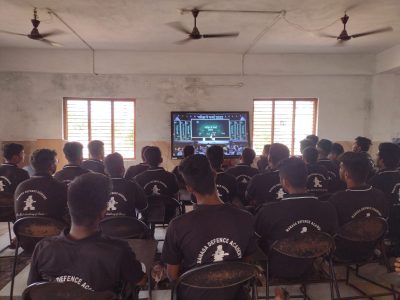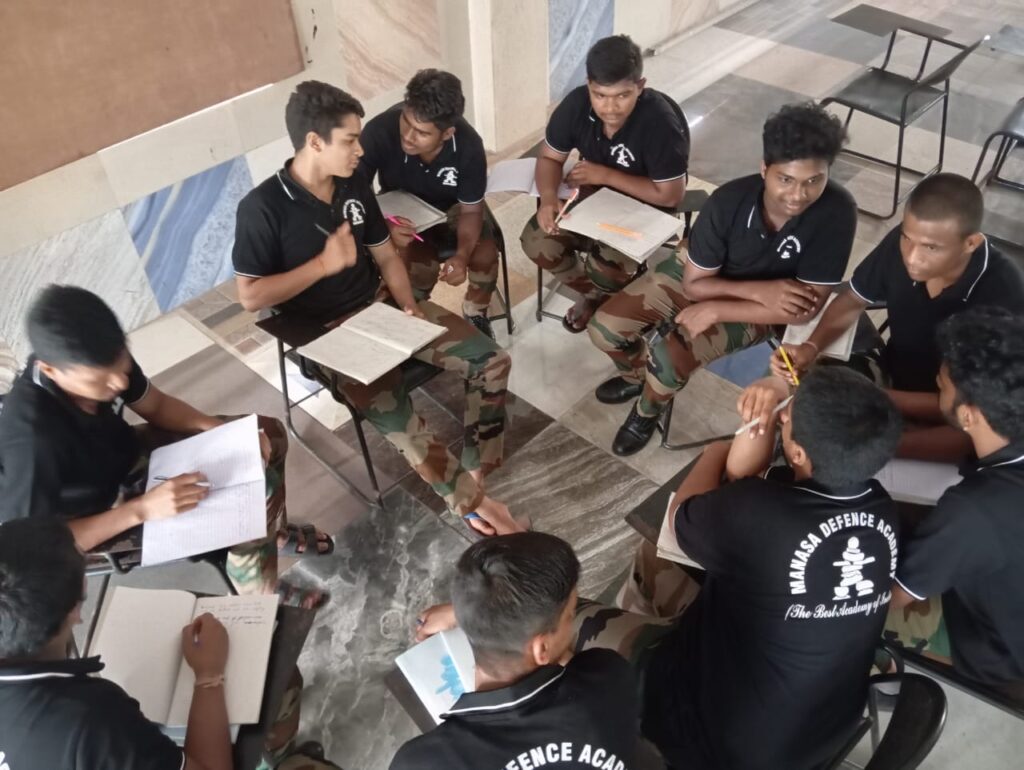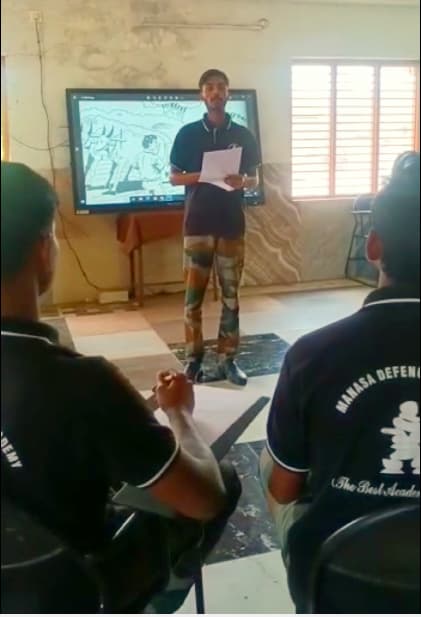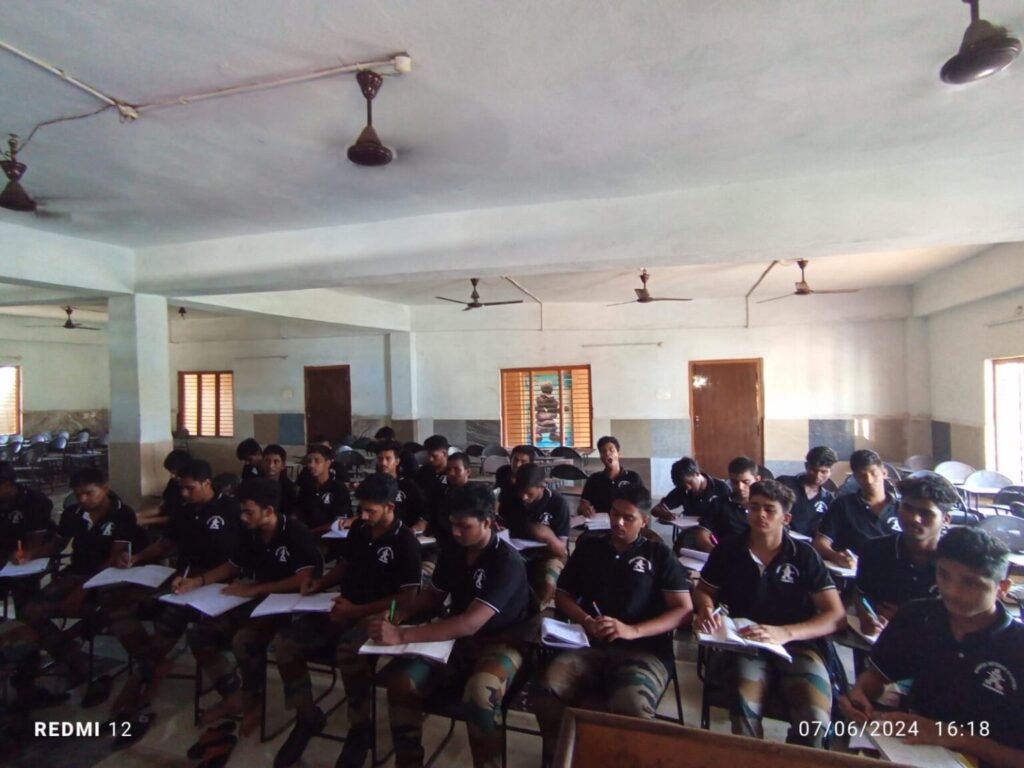NDA
(NATIONAL DEFENCE ACADEMY )

To join the NDA (National Defence Academy) requires utmost dedication and hard work including good guidance.
Manasa Defence Academy provides the best strategic training and coaching for students aspiring for the NDA.
The course for NDA in Manasa Defence Academy is well designed by experienced staff so that a competitor gets ready for each and every step i.e. written examination, group discussion, picture perception and description test, SSB interviews etc.
NDA Exam Procedure and Details
The NDA course of Manasa Defence Academy isn’t as normal as many other academics provide, we include the best training and coaching all over India. Besides academic training students in manasa are also provided with physical training and personality development courses (with no extra fee charges).
The NDA (National Defence Academy) Exam is one of the most prestigious exams in India for aspirants aiming to join the Indian Army, Navy, or Air Force. Conducted by the Union Public Service Commission (UPSC), the exam is the first step towards serving the nation as a Defence Officer. Here’s everything you need to know about the NDA exam procedure and details.
1. Eligibility Criteria
To appear for the NDA exam, candidates must meet the following criteria:
Age: 16.5 to 19.5 years (age varies slightly based on the notification).
Nationality: Indian citizens, or subjects of Nepal/Bhutan.
Education:
Army Wing: 12th Class pass from a recognized board.
Navy & Air Force Wing: 12th Class pass with Physics and Mathematics.
Marital Status: Unmarried candidates only.
2. NDA Exam Pattern
The NDA exam is conducted in two stages: Written Exam and SSB Interview.
Stage 1 – Written Exam:
The written exam consists of two papers:
Mathematics (300 marks, 2.5 hours)
Algebra, Trigonometry, Calculus, Vectors, Statistics, and Probability.
General Ability Test (GAT) (600 marks, 2.5 hours)
English (200 marks): Grammar, Vocabulary, Comprehension.
General Knowledge (400 marks): Physics, Chemistry, General Science, History, Geography, Current Affairs, and Civics.
Stage 2 – SSB Interview (900 marks)
Candidates who clear the written exam are called for the SSB (Services Selection Board) interview, which spans 5 days and includes:
Psychological Tests (Thematic Apperception Test, Word Association Test, Situation Reaction Test)
Group Testing Officer Tasks (Leadership, Teamwork, Communication)
Personal Interview (Personality assessment by experts)
Physical Fitness Test
The Services Selection Board (SSB) interview is a crucial part of the selection process for candidates aspiring to join the Indian Armed Forces as officers. The SSB interview process spans over five days, each designed to assess different qualities and aspects of a candidate’s personality and potential. Here’s a detailed breakdown of the five-day SSB interview process:
Day 0: Reporting Day
– **Reception and Documentation**: Candidates report to the designated SSB center and undergo initial documentation and verification.
– **Briefing**: Candidates are briefed about the SSB process, rules, and schedule for the coming days.
**Day 1: Screening Test**
– **Officer Intelligence Rating (OIR) Test**: This consists of verbal and non-verbal reasoning tests to evaluate the candidate’s intelligence and problem-solving abilities.
– **Picture Perception and Discussion Test (PPDT)**: Candidates are shown a picture for 30 seconds, after which they have to write a story based on it within 4 minutes. Following this, groups of candidates discuss their stories to reach a common narrative.
– **Shortlisting**: Based on the OIR and PPDT, some candidates are shortlisted for further testing. Those who are not shortlisted are sent back home.
**Day 2: Psychology Tests**
– **Thematic Apperception Test (TAT)**: Candidates are shown 12 pictures, including one blank slide, and they need to write a story for each picture within a limited time.
– **Word Association Test (WAT)**: A series of 60 words is shown, one at a time, and candidates have to write a sentence for each word in 15 seconds.
– **Situation Reaction Test (SRT)**: Candidates are given 60 situations and must write their reactions to each within 30 minutes.
– **Self-Description Test (SDT)**: Candidates write about their own views on their parents, friends, teachers, and themselves, and also mention what qualities they wish to develop.
**Day 3: Group Testing – Part 1**
– **Group Discussion (GD)**: Candidates participate in two rounds of group discussions on different topics.
– **Group Planning Exercise (GPE)**: A situation is given to the group, and they must collectively come up with a solution, followed by individual written solutions and a discussion to arrive at a final group solution.
– **Progressive Group Task (PGT)**: Groups tackle a series of obstacles with the help of certain aiding materials like planks, ropes, etc.
– **Group Obstacle Race (GOR)**: Also known as the Snake Race, this involves groups competing against each other while overcoming a series of obstacles.
– **Half Group Task (HGT)**: Similar to PGT but with smaller groups, allowing for better individual assessment.
**Day 4: Group Testing – Part 2**
– **Lecturette**: Candidates give a short lecture on a topic selected from a set of given topics.
– **Individual Obstacles (IO)**: Candidates attempt to complete a series of obstacles within a specified time.
– **Command Task (CT)**: Candidates are assigned to lead a small group and solve an obstacle/problem.
– **Final Group Task (FGT)**: Similar to PGT but the entire group works together.
**Day 5: Personal Interview**
– **Personal Interview (PI)**: Each candidate undergoes a personal interview with an interviewing officer. The interview focuses on the candidate’s background, education, achievements, interests, and various other personal aspects.
– **Conference**: All assessors (psychologists, GTOs, and interviewing officers) gather to discuss and evaluate each candidate’s performance. Candidates are called in one by one, and the final results are announced.
**Post-Conference**
– **Result Announcement**: Candidates who are recommended by the board are informed and briefed about further medical examinations.
– **Medical Examination**: Recommended candidates undergo a thorough medical examination to ensure they meet the medical standards for the Armed Forces.
– **Final Merit List**: After clearing the medical examination, a final merit list is prepared based on the candidate’s performance in the SSB interview and their medical fitness.
This five-day SSB interview process is designed to assess a candidate’s mental, physical, and emotional suitability for a career as an officer in the Indian Armed Forces.
3. Physical and Medical Standards
Candidates must meet strict physical and medical standards, including:
| Service | Minimum Height | Weight | Vision | Other Requirements |
|---|---|---|---|---|
| Army | 157.5 cm | Proportional to height | 6/6 (distance), 6/12 (near, corrected) | No major medical issues, normal chest expansion |
| Navy | 162.5 cm | Proportional | 6/6 (distance), 6/12 (near, corrected) | No color blindness, normal hearing, good dental and cardiac health |
| Air Force | 162.5 cm | Proportional | 6/6 (distance), 6/9 (near, uncorrected/with lenses) | No color blindness, good mental & physical fitness, normal chest and respiratory function |
4. Selection Procedure
The final selection is based on the combined marks of the written exam and SSB interview. Only candidates with good academic, physical, and personality scores are selected.
5. NDA Training
Selected candidates undergo training at the National Defence Academy, Pune, followed by service-specific training at the respective service academies:
Indian Army Academy, Dehradun
Indian Naval Academy, Ezhimala
Air Force Academy, Hyderabad
6. Career Opportunities
After completing NDA training, cadets are commissioned as Lieutenants in the Army, Sub-Lieutenants in the Navy, or Flying Officers in the Air Force. The career offers prestige, adventure, and opportunities to serve the nation.
SSB INTREVIEW PROCEDURE
The Services Selection Board (SSB) interview is a crucial part of the selection process for candidates aspiring to join the Indian Armed Forces as officers. The SSB interview process spans over five days, each designed to assess different qualities and aspects of a candidate’s personality and potential. Here’s a detailed breakdown of the five-day SSB interview process:
**Day 0: Reporting Day**
– **Reception and Documentation**: Candidates report to the designated SSB center and undergo initial documentation and verification.
– **Briefing**: Candidates are briefed about the SSB process, rules, and schedule for the coming days.
**Day 1: Screening Test**
– **Officer Intelligence Rating (OIR) Test**: This consists of verbal and non-verbal reasoning tests to evaluate the candidate’s intelligence and problem-solving abilities.
– **Picture Perception and Discussion Test (PPDT)**: Candidates are shown a picture for 30 seconds, after which they have to write a story based on it within 4 minutes. Following this, groups of candidates discuss their stories to reach a common narrative.
– **Shortlisting**: Based on the OIR and PPDT, some candidates are shortlisted for further testing. Those who are not shortlisted are sent back home.
**Day 2: Psychology Tests**
– **Thematic Apperception Test (TAT)**: Candidates are shown 12 pictures, including one blank slide, and they need to write a story for each picture within a limited time.
– **Word Association Test (WAT)**: A series of 60 words is shown, one at a time, and candidates have to write a sentence for each word in 15 seconds.
– **Situation Reaction Test (SRT)**: Candidates are given 60 situations and must write their reactions to each within 30 minutes.
– **Self-Description Test (SDT)**: Candidates write about their own views on their parents, friends, teachers, and themselves, and also mention what qualities they wish to develop.
**Day 3: Group Testing – Part 1**
– **Group Discussion (GD)**: Candidates participate in two rounds of group discussions on different topics.
– **Group Planning Exercise (GPE)**: A situation is given to the group, and they must collectively come up with a solution, followed by individual written solutions and a discussion to arrive at a final group solution.
– **Progressive Group Task (PGT)**: Groups tackle a series of obstacles with the help of certain aiding materials like planks, ropes, etc.
– **Group Obstacle Race (GOR)**: Also known as the Snake Race, this involves groups competing against each other while overcoming a series of obstacles.
– **Half Group Task (HGT)**: Similar to PGT but with smaller groups, allowing for better individual assessment.
**Day 4: Group Testing – Part 2**
– **Lecturette**: Candidates give a short lecture on a topic selected from a set of given topics.
– **Individual Obstacles (IO)**: Candidates attempt to complete a series of obstacles within a specified time.
– **Command Task (CT)**: Candidates are assigned to lead a small group and solve an obstacle/problem.
– **Final Group Task (FGT)**: Similar to PGT but the entire group works together.
**Day 5: Personal Interview**
– **Personal Interview (PI)**: Each candidate undergoes a personal interview with an interviewing officer. The interview focuses on the candidate’s background, education, achievements, interests, and various other personal aspects.
– **Conference**: All assessors (psychologists, GTOs, and interviewing officers) gather to discuss and evaluate each candidate’s performance. Candidates are called in one by one, and the final results are announced.
**Post-Conference**
– **Result Announcement**: Candidates who are recommended by the board are informed and briefed about further medical examinations.
– **Medical Examination**: Recommended candidates undergo a thorough medical examination to ensure they meet the medical standards for the Armed Forces.
– **Final Merit List**: After clearing the medical examination, a final merit list is prepared based on the candidate’s performance in the SSB interview and their medical fitness.
This five-day SSB interview process is designed to assess a candidate’s mental, physical, and emotional suitability for a career as an officer in the Indian Armed Forces.



GROUP DISEUSSION (GD)
PICTURE DESCRIPTION TEST
(PDT)
THEMATIC APPERCEPTION TEST (TAT)
“BEST NDA COACHING IN INDIA – MANASA DEFENCE ACADEMY”
